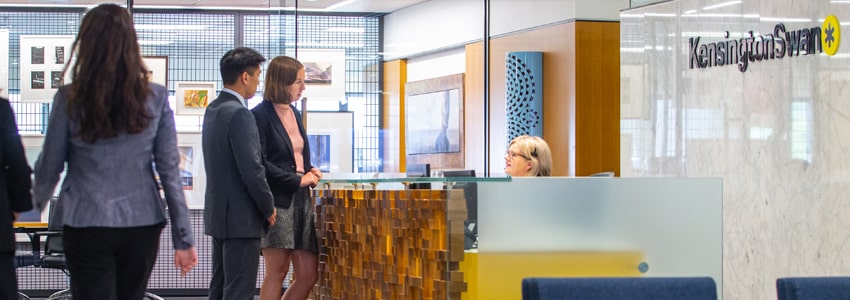Flexible, Agile, Green, Diversity, Balance, Wellbeing. Not just buzz words...
It isn’t just millennials who are demanding more flexible working practices. And more flexible working practices are changing the nature of the buildings we work in. How can that be reflected in lease arrangements?
Brought to you by our friends at Kensington Swan
Tenants and their employees are increasing demanding adaptable higher-spec work places. It is no longer sufficient to have any old office space on the outskirts of a city’s CBD, where for decades all that has changed is the dust in the corners and the name plates on the office doors. But equally, the idea that by now everyone would be working from home and the traditional office would be dead is far from the reality. People are social animals, and want to work with and around other people. They want the flexibility to work from home, or in a café on occasion, but they still want a hub and the resulting interaction and collaboration with their colleagues.
Accordingly, office location and fitout are more than ever a crucial part of the employment brand and a marker of a business’ identity to its staff, its customers and its competitors. They might be the latest buzz words, but the concepts behind them are key for organisations who seek to demonstrate that they are employers of choice, with engaged teams working happily at times that suit them in places that suit them (and the resulting impact on productivity). The working environment and therefore the relationship between landlord and tenant becomes more important than ever.
Reducing floor area doesn’t mean reducing costs
We all thought that the rapidly decreasing floor area per employee would lead to decreases in costs for businesses (as requirements for office space decreased while staff numbers remained static or increase). However, what has happened in practice is that many businesses are using the same spend to increase the quality of the office space. Instead of large offices in a C or D grade building, people are now leasing an area the third of the size in an A grade or Premium building for roughly the same costs. Even with the construction of Commercial Bay, demand for Premium and A-Grade office space in Auckland still outstrips supply.
Landlords have been quick to demonstrate how some of the older Premium or A-Grade Buildings can be retrofitted to meet the demands of more modern workplaces (and compete with Commercial Bay). Kiwi Property has shown with own spectacular and highly functional “agile” offices on Level 7 of the Vero Centre how drastically even the floor plates and style of such an iconic blue chip building can be changed from the original “individual offices with doors” fitout. And Goodman has similarly created a gorgeous showroom floor for its own “ABW” (activity based work) offices in the KPMG building – a digital first strategy and a five-star Green Star Office Interior Rating including a living moss wall.
Co-working – not just for creatives
The increasing number of co-working spaces has also been a game charger in landlords’ ability to offer this kind of fluidity. When the concept was first developed, the perception was that these would be for start-ups or people working on their own – something you used because you couldn’t access a more traditional office. However, much larger businesses are now using them to allow for constant change in work spaces (and to piggyback off the buzz created by the best of these spaces). It means that you can expand your desk numbers for a specific project or a peak business period (e.g. year-end) or shrink when someone resigns.
Co-working spaces have impacted the market in two ways – some tenants are occupying co-working spaces instead of traditional leases, others are taking a traditional lease in a building where there is additional co-working space to allow for overflow. The co-location of a traditional lease with co-working spaces also allows for tenants to access high quality meeting rooms and event spaces without the ongoing overheads. Precinct Properties’ investment in Generator has been a fantastic solution both to attract tenants and secure desired occupancy levels across the portfolio.
Realising potential: being flexible in space and time
One of the biggest changes we have seen recently is tenants’ desire for greater flexibility on the amount of space they require and the length of time they need it for. While landlords will always push for lengthy fixed term leases with comprehensive end of term make-good obligations, many of the longer term leases recently announced in the market actually have some or all of the following:
Break clauses;
- First rights of refusal to spaces within a building (ideal for a growing business);
- The ability to drop floors/areas at certain points in the lease term;
- A commitment to relocate a tenant within the landlord’s portfolio;
- Limited make-good obligations (acknowledging that these have become simply balloon cash payments to be negotiated by the parties at lease end); and
- The ability for a tenant to sub-let or share their space with other businesses, or share meeting rooms/event spaces/ reception areas.
Do your lease documents reflect how your business works?
Modern lease documents can remain ahead of the curve by offering tenants the flexible environments that their staff demand, while still satisfying commercial needs. Experienced in acting for commercial landlords and tenant clients, Kensington Swan’s market leading property team are experts in all aspects of the modern leasing environment.
For legal assistance with your lease arrangements, contact Paula Ormandy at Kensington Swan.
For your office leasing needs:

